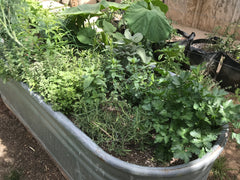Grow a Culinary Herb Garden
Posted May 13, 2022 in

Herbs not only add flavor to your food, but they add so many health benefits as well. You can grow them almost anywhere! Get creative with where you could put them. Add some in a flower garden, with your vegetables, in raised beds, or in a row. How about right outside our kitchen window, or mixed with annual flower pots. How about a front door entrance? After all, rosemary is good luck! Tulsi is a must for good energy! How about in an old horse trough, an old colander lined with weed block to hold the dirt in. Smart pots are excellent for growing herbs! Get creative! As long as you have 6 hours of sunlight, you can grow an herb garden!
A selection of different herbs is an important component of any kitchen garden arguably, almost as important as your vegetables and fruits themselves. For cooking, herbs are essential, but they also have countless medicinal, cosmetic, and household uses. And, if you grow them yourself you’ll not only be able to use them more liberally but also take the opportunity to experiment with unusual herbs that may be difficult to buy in the store.
These days fresh herbs have gotten expensive and dried herbs lack the fresh flavor, due to the drying process or how long they have been on the shelf. Herbs are easy to grow, so why not give them a go this year?
A native of tropical Asia basil needs warmth and sunshine it can be tricky to grow outdoors and cool climates. Pick leaves regularly and pinch out growing tips to encourage bushy growth.
Of the two varieties French and Russian, French has the best flavor, mild, peppery, anise seed taste. It is best to buy potted plants or propagate from an existing one. Mulch plants with straw over winter.
An annual with tiny, feathery, anise tasting leaves. Grow in a partial shady location and sow seeds direct into the ground at the time between spring or fall. Water plants regularly in the summer.
A grass like Perennial that is a member of the onion family. Both leaves and flowers can be eaten. Grow from seed sown in spring, or propagate establish clumps by dividing them in the fall. Plants can be found at most nurseries.
A little tricky to grow in hot climates. Start from seed in the ground in February through March depending on your climate. Cilantro has distinctive tasting leaves know best for Mexican dishes and its seeds are used as a spice known as coriander. Harvest leaves and water regularly to stop the plants from bolting. Can be grown in the fall in mild climates. Cilantro has been know for removing metals in the body.
There are many varieties of thyme with subtle flavors and best bought as plants rather than as seeds. Once established, they can be propagated by division, from cuttings, or by layering. Prune quite hard after flowering to stimulate the growth of new leaves.
Related to dill and with a very similar look, fennel is actually a different species. Sow direct from seed from April onward, and in fall cut all the foliage down to the ground level. You can save the seed heads and dry them for culinary use. The seeds make a nice tea that is soothing to the tummy.
Marjoram
Marjoram loves warmth and sunshine. It can be tricky to germinate, so buy potted plants or propagate from cuttings or root division. Marjoram dries lovely.
Both summer and winter savory have small evergreen leaves that look and taste a bit like thyme. Summer savory is an annual, and winter savory a perennial. Sow seeds either in spring or summer. The leaves taste best while they are still young.
Mint
Mint comes in so many flavors! From pineapple to ginger. This year we are growing a strawberry mint. Mint can be invasive! To prevent it from spreading, plant in a pot.
An evergreen with gray-green, purple, or variegated leaves. Easiest grown from a transplant. Cut back established plants in spring and pinch out growing shoots in summer to keep bushes compact and healthy.
An aromatic, evergreen shrub that likes warmth and sunshine. Rosemary will tolerate the worst of soils, it is drought tolerant and when blooming the bees love to feed on it. Prune in the spring to keep bushes in shape. Rosemary is excellent to prepare with meats, as it helps with digestion.
An annual with feathery, fern like leaves that have delicate anise flavor. The seeds have a stronger taste. The seed heads are excellent used when making pickles. Dill dislikes being disturbed so sow directly in the ground in batches between about April and July. Water regularly to prevent it from prematurely going to seed.
Parsley
Parsley comes in both curly and flat leaf varieties. The plant is a biennial. If planting by seed, be patient as parsley is slow to germinate. Parsley is excellent to add flavor to many dishes, but have many health benefits as well.



Comments (0 Comments)
There are no comments.
Post Comment